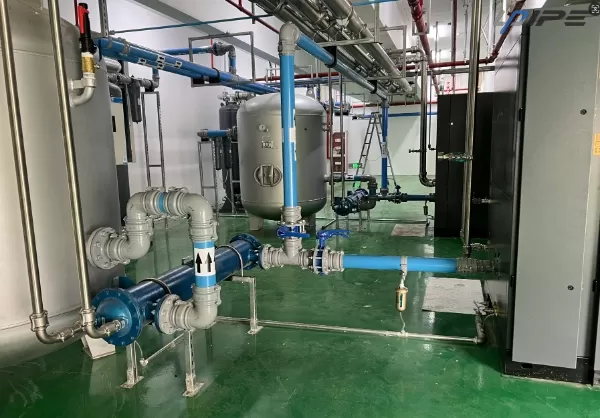As a high quality compressed air system solutions supplier, UPIPE will share the manufacturing process of high pressure aluminum compressed air pipe for sale.
Learn more
The industrial landscape is evolving rapidly, and so are the technologies that sustain it. Among these, aluminium compressed air pipe lines have emerged as a cornerstone for efficient, durable, and precise air distribution systems. In this blog post, UPIPE, a high performance compressed air line system exporter, will share the aluminum compressed air pipe line construction, as well as its materials, and installation, etc.
Aluminium compressed air pipe line construction begins with precision extrusion processes. High-strength aluminium alloys are selected for their unique balance of lightweight properties and mechanical resilience. Unlike traditional steel or plastic pipes, aluminium offers a consistent cross-section that minimizes turbulence, pressure drops, and flow inconsistencies in compressed air networks.
The joining methods of aluminium pipelines are equally crucial. Modular fittings, flared connections, and push-to-connect couplings are designed to ensure airtight seals while allowing for flexible system modifications. This structural consistency is a key factor in maintaining operational integrity over time.
Exploring the material composition of aluminium compressed air pipe lines reveals the reasons behind their adoption in precision industries. Aluminium alloys used in these pipelines are engineered to resist corrosion, fatigue, and thermal stress. Microstructural enhancements, such as grain refinement and surface anodization, improve durability while reducing the potential for air contamination caused by corrosion particles.
Furthermore, the lightweight nature of aluminium reduces installation stress on building structures. Unlike heavier metals, aluminium piping does not require reinforced supports, which allows designers to prioritize space optimization and architectural integration without compromising performance.

Efficient installation of aluminium compressed air pipe lines requires a deep understanding of modular design principles and flow dynamics. Sections are often pre-fabricated with precise tolerances, reducing on-site labor requirements and minimizing potential errors.
Engineers emphasize careful layout planning, where pipe diameters and lengths are chosen based on compressed air demand and velocity constraints. Gradual bends, rather than sharp angles, preserve pressure stability, while standardized connectors ensure rapid assembly and system scalability.
Maintaining aluminium compressed air pipe line systems extends beyond periodic inspections. Predictive maintenance leverages sensors to monitor pressure fluctuations, detect micro-leaks, and identify corrosion hotspots. This proactive approach ensures operational continuity while optimizing energy consumption.
Additionally, the non-ferrous nature of aluminium reduces the accumulation of rust and scale, simplifying cleaning procedures. Routine system flushing and joint inspections prevent particle accumulation, which is essential for sensitive applications in medical or electronic manufacturing sectors.
Thermal management in aluminium compressed air pipe lines is a critical design factor. Aluminium' s high thermal conductivity facilitates rapid heat dissipation, helping maintain stable air temperatures in long pipeline runs. Engineers can integrate heat exchangers or insulation selectively, depending on environmental exposure and compressed air requirements.
Acoustic performance is another important consideration. Aluminium pipelines produce less vibration compared to steel, and the modular design allows for noise-dampening elements to be inserted at strategic points, creating a quieter operational environment.
The future of aluminium compressed air pipe line innovation includes smart integration with digital monitoring systems. IoT-enabled sensors embedded directly into pipe segments can track real-time pressure, detect leaks, and predict system degradation. Such advancements transform traditional pipeline networks into intelligent infrastructures that support predictive maintenance and operational efficiency.
Another trend is hybrid systems, where aluminium sections are combined with composite or reinforced polymer pipelines to balance cost, flexibility, and performance. This integration allows designers to tailor pipelines to unique industrial conditions without sacrificing structural integrity.
Adherence to safety standards is essential in aluminium compressed air pipe line engineering. International norms, such as ISO 8573 for air quality and ISO 4413 for pneumatic systems, guide the design, installation, and operation of these pipelines. Compliance ensures that materials, pressure ratings, and joint integrity meet rigorous safety benchmarks, minimizing risks in high-pressure industrial environments.
Modern aluminium compressed air pipe lines are more than just conduits for air—they represent a sophisticated synthesis of material science, engineering precision, and operational intelligence. By considering construction, material innovation, installation dynamics, maintenance strategies, and smart technology integration, industries can harness the full potential of aluminium air distribution systems. This holistic perspective ensures that pipelines remain reliable, adaptable, and efficient in the evolving industrial landscape.